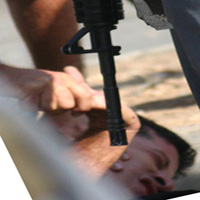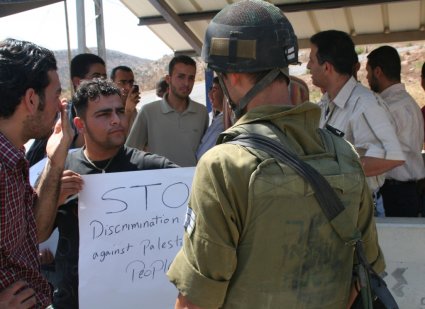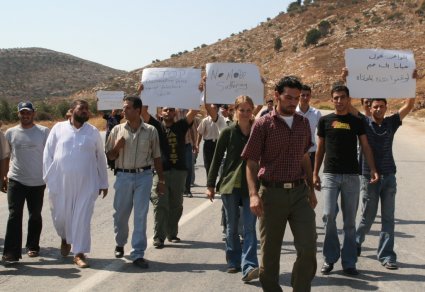By Patrick Cockburn in Gaza
Gaza is dying. The Israeli siege of the Palestinian enclave is so tight that its people are on the edge of starvation. Here on the shores of the Mediterranean a great tragedy is taking place that is being ignored because the world’s attention has been diverted by wars in Lebanon and Iraq.
A whole society is being destroyed. There are 1.5 million Palestinians imprisoned in the most heavily populated area in the world. Israel has stopped all trade. It has even forbidden fishermen to go far from the shore so they wade into the surf to try vainly to catch fish with hand-thrown nets.
Many people are being killed by Israeli incursions that occur every day by land and air. A total of 262 people have been killed and 1,200 wounded, of whom 60 had arms or legs amputated, since 25 June, says Dr Juma al-Saqa, the director of the al-Shifa Hospital in Gaza City which is fast running out of medicine. Of these, 64 were children and 26 women. This bloody conflict in Gaza has so far received only a fraction of the attention given by the international media to the war in Lebanon.
It was on 25 June that the Israeli soldier Gilad Shalit was taken captive and two other soldiers were killed by Palestinian militants who used a tunnel to get out of the Gaza Strip. In the aftermath of this, writes Gideon Levy in the daily Haaretz, the Israeli army “has been rampaging through Gaza – there’s no other word to describe it – killing and demolishing, bombing and shelling, indiscriminately”. Gaza has essentially been reoccupied since Israeli troops and tanks come and go at will. In the northern district of Shajhayeh they took over several houses last week and stayed five days. By the time they withdrew, 22 Palestinians had been killed, three houses were destroyed and groves of olive, citrus and almond trees had been bulldozed.
Fuad al-Tuba, the 61-year-old farmer who owned a farm here, said: “They even destroyed 22 of my bee-hives and killed four sheep.” He pointed sadly to a field, its brown sandy earth churned up by tracks of bulldozers, where the stumps of trees and broken branches with wilting leaves lay in heaps. Near by a yellow car was standing on its nose in the middle of a heap of concrete blocks that had once been a small house.
His son Baher al-Tuba described how for five days Israeli soldiers confined him and his relatives to one room in his house where they survived by drinking water from a fish pond. “Snipers took up positions in the windows and shot at anybody who came near,” he said. “They killed one of my neighbours called Fathi Abu Gumbuz who was 56 years old and just went out to get water.”
Sometimes the Israeli army gives a warning before a house is destroyed. The sound that Palestinians most dread is an unknown voice on their cell phone saying they have half an hour to leave their home before it is hit by bombs or missiles. There is no appeal.
But it is not the Israeli incursions alone that are destroying Gaza and its people. In the understated prose of a World Bank report published last month, the West Bank and Gaza face “a year of unprecedented economic recession. Real incomes may contract by at least a third in 2006 and poverty to affect close to two thirds of the population.” Poverty in this case means a per capita income of under $2 (£1.06) a day.
There are signs of desperation everywhere. Crime is increasing. People do anything to feed their families. Israeli troops entered the Gaza industrial zone to search for tunnels and kicked out the Palestinian police. When the Israelis withdrew they were replaced not by the police but by looters. On one day this week there were three donkey carts removing twisted scrap metal from the remains of factories that once employed thousands.
“It is the worst year for us since 1948 [when Palestinian refugees first poured into Gaza],” says Dr Maged Abu-Ramadan, a former ophthalmologist who is mayor of Gaza City. “Gaza is a jail. Neither people nor goods are allowed to leave it. People are already starving. They try to live on bread and falafel and a few tomatoes and cucumbers they grow themselves.”
The few ways that Gazans had of making money have disappeared. Dr Abu-Ramadan says the Israelis “have destroyed 70 per cent of our orange groves in order to create security zones.” Carnations and strawberries, two of Gaza’s main exports, were thrown away or left to rot. An Israeli air strike destroyed the electric power station so 55 per cent of power was lost. Electricity supply is now becoming almost as intermittent as in Baghdad.
The Israeli assault over the past two months struck a society already hit by the withdrawal of EU subsidies after the election of Hamas as the Palestinian government in March. Israel is withholding taxes owed on goods entering Gaza. Under US pressure, Arab banks abroad will not transfer funds to the government.
Two thirds of people are unemployed and the remaining third who mostly work for the state are not being paid. Gaza is now by far the poorest region on the Mediterranean. Per capita annual income is $700, compared with $20,000 in Israel. Conditions are much worse than in Lebanon where Hizbollah liberally compensates war victims for loss of their houses. If Gaza did not have enough troubles this week there were protest strikes and marches by unpaid soldiers, police and security men. These were organised by Fatah, the movement of the Palestinian President Mahmoud Abbas, also known as Abu Mazen, which lost the election to Hamas in January. His supporters marched through the streets waving their Kalashnikovs in the air. “Abu Mazen you are brave,” they shouted. “Save us from this disaster.” Sour-looking Hamas gunmen kept a low profile during the demonstration but the two sides are not far from fighting it out in the streets.
The Israeli siege and the European boycott are a collective punishment of everybody in Gaza. The gunmen are unlikely to be deterred. In a bed in Shifa Hospital was a sturdy young man called Ala Hejairi with wounds to his neck, legs, chest and stomach. “I was laying an anti-tank mine last week in Shajhayeh when I was hit by fire from an Israeli drone,” he said. “I will return to the resistance when I am better. Why should I worry? If I die I will die a martyr and go to paradise.”
His father, Adel, said he was proud of what his son had done adding that three of his nephews were already martyrs. He supported the Hamas government: “Arab and Western countries want to destroy this government because it is the government of the resistance.”
As the economy collapses there will be many more young men in Gaza willing to take Ala Hejairi’s place. Untrained and ill-armed most will be killed. But the destruction of Gaza, now under way, will ensure that no peace is possible in the Middle East for generations to come.
The deadly toll
* After the kidnap of Cpl Gilad Shalit by Palestinians on 25 June, Israel launched a massive offensive and blockade of Gaza under the operation name Summer Rains.
* The Gaza Strip’s 1.3 million inhabitants, 33 per cent of whom live in refugee camps, have been under attack for 74 days.
* More than 260 Palestinians, including 64 children and 26 women, have been killed since 25 June. One in five is a child. One Israeli soldier has been killed and 26 have been wounded.
* 1,200 Palestinians have been injured, including up to 60 amputations. A third of victims brought to hospital are children.
* Israeli warplanes have launched more than 250 raids on Gaza, hitting the two power stations and the foreign and Information ministries.
* At least 120 Palestinian structures including houses, workshops and greenhouses have been destroyed and 160 damaged by the Israelis.
* The UN has criticised Israel’s bombing, which has caused an estimated $1.8bn in damage to the electricity grid and leaving more than a million people without regular access to drinking water.
* The Israeli human rights group B’Tselem says 76 Palestinians, including 19 children, were killed by Israeli forces in August alone. Evidence shows at least 53 per cent were not participating in hostilities.
* In the latest outbreak of violence, three Palestinians were killed yesterday when Israeli troops raided a West Bank town in search of a wanted militant. Two of those killed were unarmed, according to witnesses.
Gaza is dying. The Israeli siege of the Palestinian enclave is so tight that its people are on the edge of starvation. Here on the shores of the Mediterranean a great tragedy is taking place that is being ignored because the world’s attention has been diverted by wars in Lebanon and Iraq.
A whole society is being destroyed. There are 1.5 million Palestinians imprisoned in the most heavily populated area in the world. Israel has stopped all trade. It has even forbidden fishermen to go far from the shore so they wade into the surf to try vainly to catch fish with hand-thrown nets.
Many people are being killed by Israeli incursions that occur every day by land and air. A total of 262 people have been killed and 1,200 wounded, of whom 60 had arms or legs amputated, since 25 June, says Dr Juma al-Saqa, the director of the al-Shifa Hospital in Gaza City which is fast running out of medicine. Of these, 64 were children and 26 women. This bloody conflict in Gaza has so far received only a fraction of the attention given by the international media to the war in Lebanon.
It was on 25 June that the Israeli soldier Gilad Shalit was taken captive and two other soldiers were killed by Palestinian militants who used a tunnel to get out of the Gaza Strip. In the aftermath of this, writes Gideon Levy in the daily Haaretz, the Israeli army “has been rampaging through Gaza – there’s no other word to describe it – killing and demolishing, bombing and shelling, indiscriminately”. Gaza has essentially been reoccupied since Israeli troops and tanks come and go at will. In the northern district of Shajhayeh they took over several houses last week and stayed five days. By the time they withdrew, 22 Palestinians had been killed, three houses were destroyed and groves of olive, citrus and almond trees had been bulldozed.
Fuad al-Tuba, the 61-year-old farmer who owned a farm here, said: “They even destroyed 22 of my bee-hives and killed four sheep.” He pointed sadly to a field, its brown sandy earth churned up by tracks of bulldozers, where the stumps of trees and broken branches with wilting leaves lay in heaps. Near by a yellow car was standing on its nose in the middle of a heap of concrete blocks that had once been a small house.
His son Baher al-Tuba described how for five days Israeli soldiers confined him and his relatives to one room in his house where they survived by drinking water from a fish pond. “Snipers took up positions in the windows and shot at anybody who came near,” he said. “They killed one of my neighbours called Fathi Abu Gumbuz who was 56 years old and just went out to get water.”
Sometimes the Israeli army gives a warning before a house is destroyed. The sound that Palestinians most dread is an unknown voice on their cell phone saying they have half an hour to leave their home before it is hit by bombs or missiles. There is no appeal.
But it is not the Israeli incursions alone that are destroying Gaza and its people. In the understated prose of a World Bank report published last month, the West Bank and Gaza face “a year of unprecedented economic recession. Real incomes may contract by at least a third in 2006 and poverty to affect close to two thirds of the population.” Poverty in this case means a per capita income of under $2 (£1.06) a day.
There are signs of desperation everywhere. Crime is increasing. People do anything to feed their families. Israeli troops entered the Gaza industrial zone to search for tunnels and kicked out the Palestinian police. When the Israelis withdrew they were replaced not by the police but by looters. On one day this week there were three donkey carts removing twisted scrap metal from the remains of factories that once employed thousands.
“It is the worst year for us since 1948 [when Palestinian refugees first poured into Gaza],” says Dr Maged Abu-Ramadan, a former ophthalmologist who is mayor of Gaza City. “Gaza is a jail. Neither people nor goods are allowed to leave it. People are already starving. They try to live on bread and falafel and a few tomatoes and cucumbers they grow themselves.”
The few ways that Gazans had of making money have disappeared. Dr Abu-Ramadan says the Israelis “have destroyed 70 per cent of our orange groves in order to create security zones.” Carnations and strawberries, two of Gaza’s main exports, were thrown away or left to rot. An Israeli air strike destroyed the electric power station so 55 per cent of power was lost. Electricity supply is now becoming almost as intermittent as in Baghdad.
Published: 08 September 2006





